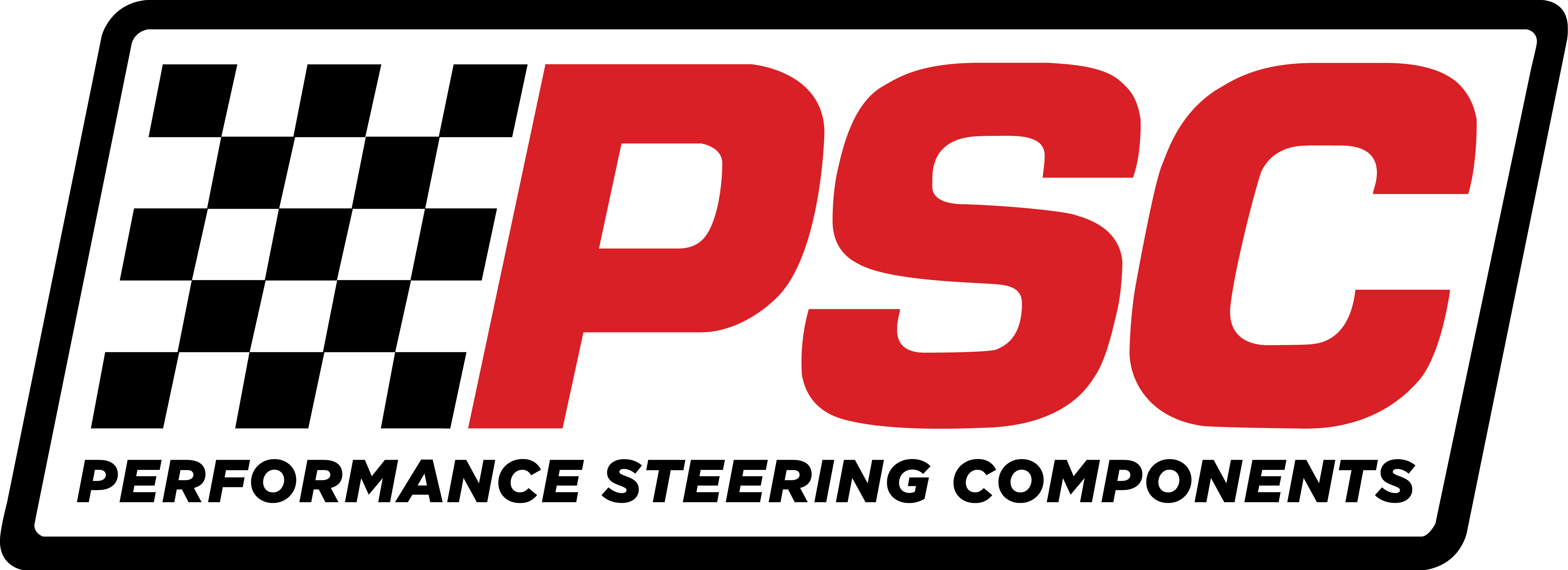Where can I find installation instructions for my PSC product?
Our available Installation Guides can be found here, www.flipsnack.com/runpsc
SELECT QUICK LINKS:
Bleeding Procedure
Remote Fluid Reservoir Fill Level
SK688R38JP1 - 2007-11 Jeep JK 3.8L
SK688R36JP1 - 2012-18 Jeep JK 3.6L
2007-18 Jeep JK OE Cylinder Assist™ Installation
2007-18 Jeep JK SG688/R Bolt Placement
SK689R20JP1 - 2018-Newer Jeep JL 2.0T
2018-2022 Jeep JL/JT SG689/R Bolt Placement
SK752R73FDP-OE - 1999-2003 Ford Super Duty 7.3L, 2000-2003 Ford Excursion 7.3L
I can't find information about my component using the part number on the white PSC sticker?
The number on the white PSC sticker (see examples below) is an internal Manufacturing Tracking Serial Number, it is NOT a part number.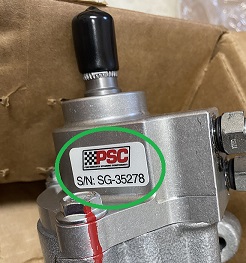
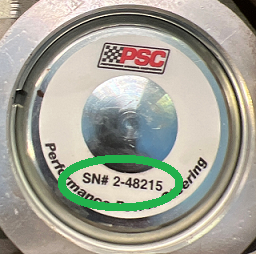
How can I tell which port is which on my reservoir? 
Where can I find the part number of my PSC component?
PSC Steering Gear part numbers are typically stamped into the case or input shaft gland nut: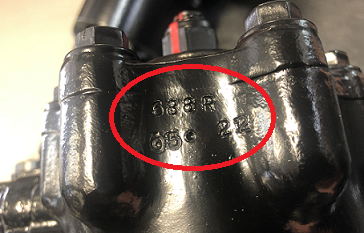
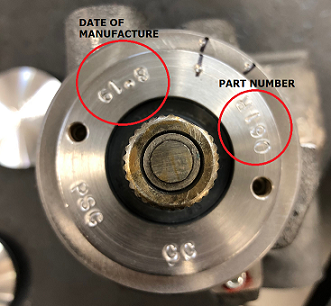
PSC pumps do not have a part number stamp. As a reference, the three different types of pumps we offer can be found here. Contact Us if you need assistance.
How do I bleed my power steering system?
Review our bleeding instructions here.
What is the fill level on a PSC Remote Fluid Reservoir?
Halfway between the upper solid black line of the PSC logo and the weld bead at the top of the reservoir (PSC Bleeding Procedures).
Where does this rubber hose on the top of my Remote Fluid Reservoir connect?
On offroad applications, the rubber hose inserted into the 90° elbow is the vent line. This should be connected to a PSC Fluid Anti-Splash Valve.
What does JIC mean? What is the difference between JIC and AN?
JIC is an abbreviation for Joint Industries Council, the first entity to standardize industrial use fittings. JIC fittings feature a 37° flared seat on both male and female threaded connections.
AN stands for Air Force-Navy Aeronautical Design Standards. Fittings manufactured to this designation are MIL-SPEC (US Military) standard.
What is “death wobble”? How can I fix it?
Death wobble is caused by loose or damaged mechanical steering components, not the hydraulic components, e.g. pump or steering gear. It can be a result of incorrectly installed mechanical steering or suspension parts.
The first thing that should be verified is if anything is bent or broken. Look at all of the front suspension components, and if anything's damaged, the first priority is to replace it.
Below is a checklist of possible causes from MOST PROBABLE to LEAST PROBABLE.
• Front Track Bar
• Ball Joints
• Drag Link/Tie Rod Ends
• Upper Control Arms
• Lower Control Arms
• Suspension Bushings
• Steering Stabilizer
• Steering Knuckles
The front track bar, drag link, steering knuckles, ball joints, steering stabilizer, upper and lower control arms should be checked for damage or excessive wear.
Verify that all hardware is properly tightened to the correct torque specifications.
What type/brand of power steering fluid does PSC recommend?
For conventional pump systems, PSC 715
For Electro-Hydraulic pump systems, PSC Tru Blue™ Ultra High-Performance Electric Power Steering Fluid
Why?
The #1 reason power steering pumps fail is due to cavitaition aka fluid aeration. The #1 cause of fluid aeration is fluid temperatures in excess of 180°F.
PSC 715 has a very aggressive anti-foaming formula and in testing with 15 other leading fluids used for power steering systems, it provides three (3) critical benefits:
1) Aggressive suppression of fluid aeration, especially as the fluid temperature increases
2) Quiet pump operation
3) Broad temperature range for a variety of climates
PSC 715 is not readily available to me, are there any alternatives?
As an alternative to PSC 715, PSC recommends using AC Delco Power Steering Fluid.
For vehicles being used in regions with extended periods of sub-freezing seasonal temperatures, PSC recommends using AC Delco Cold Climate Power Steering Fluid.
Is a fluid cooler recommended?
Yes! PSC recommends using a fluid cooler to protect your investment and to ensure efficient performance in all driving environments. The most detrimental effect of excessive heat in the power steering system is the breakdown of the power steering fluid which affects its ability to lubricate the vital components of the steering system, namely the pump.
Fluid temperatures should be maintained at approximately 120°F - 160°F for optimum performance, and should never be allowed to exceed 180°F.
It is strongly recommended to install fluid coolers outside the engine bay and slightly below the level of the power steering pump.
What happens if I mix fluids?
With the exception of AC Delco Power Steering Fluid, we do not recommend mixing fluids as it will dilute the anti-foaming strength of the PSC 715.
However, in the event of an emergency, use whatever products are immediately available to enable the vehicle to safely exit the trail. Once the vehicle is at home base, drain and flush the system, replace the filter, and refill with PSC 715.
A Fluid Change Kit can be purchased here, www.pscmotorsports.com/power-steering-fluid/psc-flk729.html
When installing new PSC components, do I need to flush the power steering fluid system first?
Generally, flushing the system is advised when replacing a component, e.g. catastrophic failure of a pump. Metallic debris from a catastrophic component failure can potenially damage another component in the system, e.g. steering gear or hydroboost brake unit.
Additionally, flushing the power steering system is advised as part of regular system maintenance to maintain optimal performance in the field. For example, on vehicles regularly deployed in intermediate to advanced off-road environments, it would be recommended to flush, fill, and change the filter at least once a season.
Why is fluid spilling out of the top of the reservoir and/or SR-VT Fluid Anti-Splash Valve?
The main cause of fluid loss from the reservoir is overfilling. Verify that the fluid level is halfway between the upper solid black line of the PSC logo and the weld bead at the top of the reservoir (www.flipsnack.com/runpsc/psc-power-steering-bleeding-procedures.html).
At higher pump RPMs, excessive fluid aeration becomes the secondary reason for fluid loss. Excessive air and pressure in the system will want to push up and out thru the reservoir vent.
I can't find information about my component using the part number on the white PSC sticker?
The number on the white PSC sticker (see example below) is an internal Manufacturing Tracking Serial Number, it is NOT a part number.
Where can I find the part number of my PSC steering gear?
PSC Steering Gear part numbers are typically stamped into the case or input shaft gland nut:

Contact Us if you need assistance.
Which port on the steering gear is the high-pressure port?
The LARGER of the two (2) female ports is ALWAYS the high-pressure "IN" port, or the connection directly to the high-pressure output of the pump.
On vehicles produced before 1979 and earlier, the ports have inverted flare seats and measure SAE 11/16 and 5/8-18.
On vehicles produced 1980 and later, the ports have metric o-ring seats and measure 18MM-1.50 and 16MM-1.50.
Most PSC steering gears have indicators for the high and low-pressure ports. Before installing the component, inspect case for marks that indicate the proper line connections as seen here: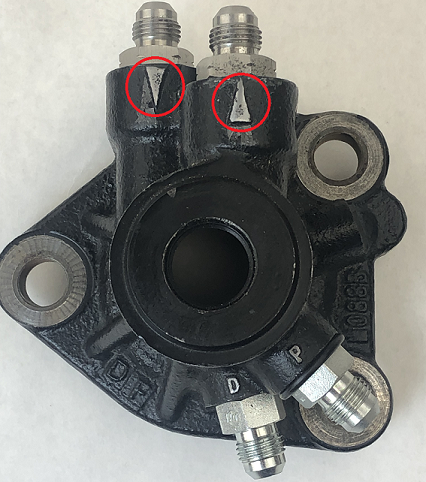
When using JIC adapter fittings, verify the line connections are correct before starting the engine. Improperly installed lines can cause damage to the steering gear.
Some specialty steering gears, especially for race applications, the ports can be the same size. Contact Us for more information.
I’m installing a cylinder assist system on my vehicle; which line goes where when connecting the steering gearbox to the steering assist cylinder?
For most applications, please follow this diagram.
Most JK, JL, and JT PSC steering gears have indicators for the Driver and Passenger ports. Before installing the component, inspect case for marks that indicate the proper line connections as seen here: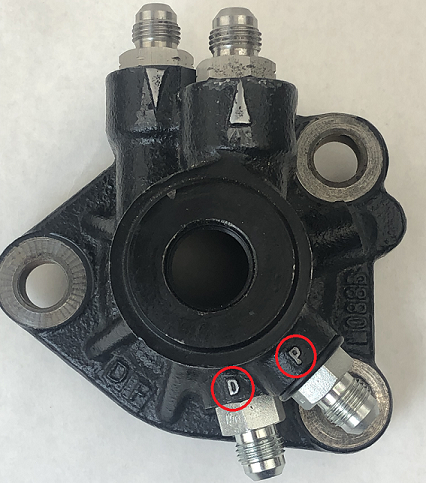
What are these o-rings zip-tied to my PSC Steering Gear?
These are replacement o-rings for the factory high-pressure hose assembly if it is being reinstalled. If the factory hose assembly is not being installed, these o-rings can be discarded.
I am not going to install the Assist Cylinder until later, do I leave these steel JIC cap nuts on the ports?
Yes. Snug them down and the vehicle can be operated as normal.
What size are the Cylinder Assist™ ports on my PSC Steering Gear?
The Cylinder Assist™ ports are -6 JIC for #6 (3/8") ID high-pressure hose.
My steering wheel will not return to center, how can I fix it?
The return-to-center issue can typically be resolved by adjusting the positive caster alignment setting after the installation of a new steering gear and/or other suspension modifications.
If the steering gear is suspected to be the cause, remove the steering gear from the vehicle and test it on the bench. Lightly attach a pair of vice grips to the input shaft (be careful not to damage the splines or mar a smooth input shaft) and rotate by hand. If binding or any other anomaly presents, then the steering gear most likely needs to be adjusted or repaired.
Contact Us for further information.
Why is my steering touchy/sketchy (hyper-sensitive) at highway speeds?
It is important to have the vehicle aligned by a qualified Off-Road Specialist after the installation of a PSC Cylinder Assist™ Steering Kit, any suspension modifications including lift kits and adjustable A-arms, and/or adjusting the axle pinion angle. An incorrect positive caster alignment setting is the leading cause of steering hyper-sensitivity.
I am experiencing bump steer, how do I fix it?
Bump steer is typically caused by one of two things: A) lifting a vehicle incorrectly or B) loose, broken, or bent suspension components.
Improperly lifting a vehicle doesn’t just mean installing something incorrectly, it mainly refers to the angles of the steering and suspension components. When a lift kit is added to a vehicle, the geometry of the mechanical aspect of the steering and suspension is changed and this requires an adjustment to keep the angles correct. Verify that the angles of the track bar and drag link are parallel to each other.
Sometimes, adjustments will require additional third-party parts, like a new bracket assembly or an adjustable version of a component.
What is the torque specification for the Pitman arm?
For most steering gears with a 1-1/8" diameter sector shaft, the torque value is 180 ft lbs. The nut size is 7/8 and requires 1-5/16 socket.
The torque value for PSC Big Bore steering gears installed on JK, JL, and JT is 220-225 ft lbs. The nut size is 30MM and requires a 46MM socket.
Where can I find the part number of my PSC pump component?
PSC pumps do not have a part number stamp. As a reference, the three different types of pumps we offer can be found here.
The number on the white PSC sticker (see examples on General Information tab) is an internal Manufacturing Tracking Serial Number, it is NOT a part number.
Contact Us if you need assistance.
How do I bleed my power steering system?
Review our bleeding instructions here.
What is the fill level on a PSC Remote Fluid Reservoir?
Halfway between the upper solid black line of the PSC logo and the weld bead at the top of the reservoir (PSC Bleeding Procedures).
Is there a different bleeding procedure if I have hydroboost braking?
Yes! After completing Steps 1-14 of the bleeding procedure, with the engine off, apply and release the brake pedal 5-10 times to purge the accumulator reserve pressure. With your foot slightly depressing the brake pedal, start the engine. The brake pedal should drop and then push back against your foot. Turn the steering wheel until lightly against the steering stop. After approximately five (5) seconds, return the wheels to the center, straight-ahead position and turn the engine off. Apply and release the brake pedal. There should be at least one (1) power assisted brake application.
Should I run an overdrive pulley on my pump?
An overdrive pulley can be used to improve steering performance at low engine RPMs, a driving condition typically found in low-speed, advanced offroad terrain environments.
As a general rule, most pumps start to create usable pressure at approximately 1100 pump RPM. Use this online pulley ratio calculator to see the difference an overdrive pulley can make on your application.
I have changed the pulley size on my pump, how do I find out what belt size I need?
Use this Wikihow to determine an overall length and then visit your local auto parts retail store to experiement with a few sizes to find the best fit.
How can I identify the type of PSC Assist or Steering Cylinder™ I have?
PSC Assist and Steering Cylinders™ have a part number engraved on the main housing between the fluid ports: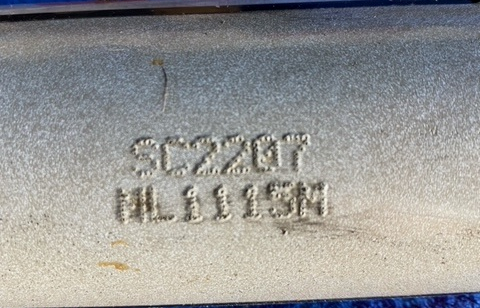
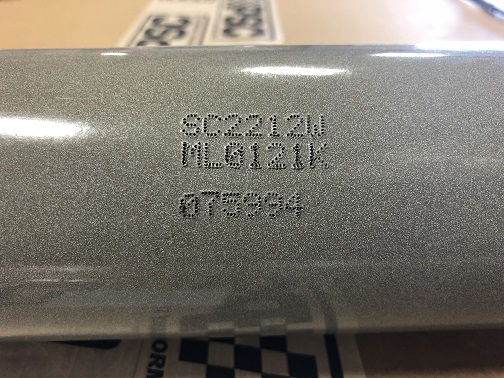
I’m installing a Cylinder Assist™ System on my vehicle; which line goes where when connecting the steering gear to the steering Assist Cylinder™?
For most applications, please follow this diagram.
Most JK, JL, and JT PSC steering gears have indicators for the Driver and Passenger ports. Before installing the component, inspect case for marks that indicate the proper line connections as seen here:

How do I determine what size cylinder I need for my project/build?
Verify the actual steering travel measurement of the axle.
Common travel measurements include:
1972-2006 Jeep D30 Axle - 6.0 Inches
1987-2006 Jeep D44 Axle - 6.0 Inches
1972-2006 Jeep with Ford Super Duty D60 Axle - 8.0 Inches
2007-2022 Jeep JK/JL/JT with Unmodified Factory Axle - 6.75 Inches
1968-1993 GM 4WD and K5 with Crossover Steering - 8.75 Inches
When required, PSC offers Cylinder Stroke Limiting service for an additional $80/unit. Please call our Sales Team 9AM-5PM CST Monday-Friday at 817-270-0102 to place an order.
Which port on the orbital valve is the HIGH-PRESSURE IN?
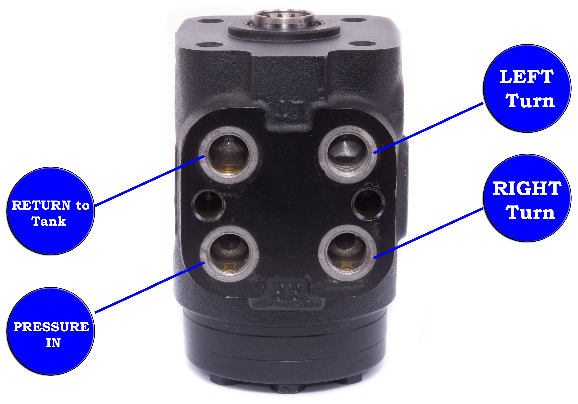
I received the HK2088-1 Hose Kit with my Full Hydraulic Steering Kit, what fittings go where?
#6 High-Pressure Hose and Fittings connects the Orbital > Steering Cylinder Turn Ports (see Question #1 Image)
#8 High-Pressure Hose and Fittings connects the Pump > High-Pressure IN of the Orbital (see Question #1 Image)
**NOTE** Install CV300 One-Way Check Valve into the High-Pressure IN of the Orbital
#8 Low-Pressure Hose connects the Orbital Low-Pressure OUT > Fluid Cooler > Remote Fluid Reservoir (Center Port)
#12 Low-Pressure Hose connects Remote Fluid Reservoir > Pump Feed
Where can I find hose routing diagrams for my Full Hydraulic project?
Full Hydralic Hose Routing Diagrams
How do I troubleshoot issues with Full Hydraulic steering?
Pump - "How To Use a Pressure Gauge to Pinpoint Power Steering Issues" by Cardone
Steering Control (Orbital) Valve - "Hydraulic Steering System Operation & Troubleshooting" by Allied Systems
Steering Cylinder - Typically the only issue with a steering cylinder is leaking seals and/or a damaged rod.
Damage to the rod can present as deep scratches or abrasions on the material surface that can either cut the rubber seals as the damaged area passes thru the seal or present a significant enough gap to allow for fluid to escape past the seal.
A bent rod assembly can cause the steering to "stick", usually in only one direction (the side of the steering cylinder with the bend). Once enough fluid pressure builds up behind the piston in the center, a minor bend can pass through the gland nut with some difficulty.
Should I install an inline one-way flow check valve in the high-pressure circuit?
PSC recommends the use of a One-Way Fluid Flow Check Valve to prevent the reverse flow of fluid back into the pump on the high-pressure side of the circuit. When reverse fluid flow happens, especially at excessive pressures, this will cause the pressure relief mechanism of the pump to trigger which will reduce the overall system pressure for as long as the pressure relief mechanism is engaged. In a worst case scenario, the extreme, sudden spike in system pressure can cause catastrophic failure of the pump.
PSC 12 MONTH LIMITED WARRANTY
Your Performance Steering Components (PSC) branded product(s) (“Product”) are warranted to be free from defects in material and workmanship for a period of ONE (1) YEAR from the date of retail purchase (“Warranty Period”) from any Authorized PSC Distributor. This Limited Warranty is non-transferrable and is applicable only to the Original Purchaser.
To obtain performance of this Limited Warranty, request a RGA (Return Goods Authorization) from PSC at any time during the Warranty Period.
Enclose a copy of the original purchase receipt, a completed warranty return form, and have the issued RGA number written on the outside of the return package in a conspicuous place.
Return prepaid freight to: Performance Steering Components (PSC) 400 Church Road Azle, Texas 76020
PSC will repair, replace or credit the product, at its election and at its sole cost, within thirty (30) days after receipt. Certain restrictions may apply.
This Limited Warranty EXCLUDES a product that fails due to i) accident or collision; ii) improper use, installation, maintenance, or service; iii) combination of the product with other third party product(s) which fail; iv) abuse, misuse, modification or neglect v) failure to follow directions; vi) an act of God (such as flood, salt, or other environmental conditions including natural disasters); vii) installation or use on vehicles used for racing purposes.
This Limited Warranty excludes any labor costs incurred for diagnosis of defect, removal and/or reinstallation of a product, towing fees, rental car charges, or any other consequential expenses, which are the sole responsibility of the Original Purchaser.
All "Custom", “Off Road Only”, “Non-Street Legal”, or “Competition” products are expressly excluded from PSC’s ONE (1) Year Limited Warranty. If a part is a custom built component and/or installed on an “Off-Road Only”, “Non-Street Legal”, or “Competition” vehicle is determined to be non-functional upon installation, contact must be made with PSC no more than thirty (30) days from date of purchase for consideration of repair or replacement.
Third Party Products not manufactured by PSC are expressly excluded. Products that may be covered by the original manufacturer’s warranty should be returned, in accordance with stated policy, to the original manufacturer.
MOTORSPORTS ARE INHERENTLY DANGEROUS, USER ASSUMES ALL RISK AND RESPONSIBILITY. THIS WARRANTY DOES NOT COVER INCIDENTAL, CONSEQUENTIAL, INDIRECT, OR SPECIAL DAMAGES. THIS LIMITED WARRANTY IS THE ONLY EXPRESS WARRANTY WHICH APPLIES TO PSC PRODUCTS AND REPRESENTS THE TOTAL LIABILITY OF PSC FOR ANY PRODUCT.
TO THE EXTENT PERMITTED BY LAW, THIS WARRANTY IS IN LIEU OF ALL OTHER EXPRESS AND IMPLIED WARRANTIES, INCLUDING THAT FOR MERCHANTABILITY OR FITNESS FOR A PARTICULAR PURPOSE IS HEREBY LIMITED BY THE SAME TERMS AND TIME LIMITATIONS SET FORTH IN THIS LIMITED EXPRESS WARRANTY AND ARE OTHERWISE EXCLUDED. ANY MODIFICATIONS, EXTENSIONS, OR ADDITIONS TO THIS LIMITED WARRANTY BY A DEALER, AGENT OR EMPLOYEE OF PSC IS NOT AUTHORIZED BY PSC.
PRODUCT ELIGIBILITY
Only items manufactured by PSC and intended for daily on-the-road use are eligible under this ONE (1) YEAR Limited Warranty. All other parts, including any custom or modified parts, will be deemed ineligible under this ONE (1) YEAR Limited Warranty and will only be guaranteed to function upon installation.
If, after inspection, a part returned under this ONE (1) YEAR Limited Warranty is deemed to be ineligible for warranty repair or replacement, the part may be repaired or replaced at cost. Return shipping charges will apply.
PSC is committed to Continuous Improvement and reserves the right to change any Product without prior notice.
PSC shall have no obligation to upgrade or modify a Product manufactured prior to a design change or revision.
THIS LIMITED WARRANTY IS APPLICABLE TO LOCATIONS WITHIN THE UNITED STATES ONLY.
NEW RETURNS
ALL RETURNS MUST BE PRE-AUTHORIZED.
PSC will accept any new, uninstalled, in resalable condition product purchased directly from PSC for return or exchange within ninety (90) days of the invoice date.
Contact support@pscmotorsports.com to obtain a Return Goods Authorization number.
When returning product, shipping charges are the sole responsibility of the Purchaser and are NON-REFUNDABLE.
Products purchased through an Authorized Distributor should be returned to the Authorized Distributor in accordance with the Authorized Vendor’s Return Policy.
Claims for damaged shipments, incorrect shipments, or short-supplied shipments must be made no later than thirty (30) calendar days from the date on the PSC or Authorized Distributor's invoice.
Missing hardware is not deemed a defect or error and is replaced at no charge upon request.
Cosmetic defect(s) (e.g. paint chipping, scratches on hydraulic cylinders) are not deemed a defect or error and will be replaced at no charge upon request.
Product ordered in error must be returned or exchanged within thirty (30) days of the invoice date. A 15% restocking fee may apply.
A 15% restocking fee is applied to most items accepted for return.
Please allow seven (7) business days after the receipt of the return for credit or refund processing.
WARRANTY RETURNS
ALL RETURNS MUST BE PRE-AUTHORIZED.
Contact support@pscmotorsports.com to obtain a Return Goods Authorization number.
Warranty returns less than NINETY (90) DAYS from the date of retail purchase qualify for PSC’s Warranty Return Free Shipping Policy.
If a Call Tag is issued for a defective item, the item must be returned within thirty (30) days to avoid additional charges.
Performance Steering Components is not responsible for accepting warranty returns of products purchased through our Authorized Distributors if the purchase is covered by the Authorized Distributor’s Return Policy. End User must return the product to the Authorized Distributor from whom the product was originally purchased in accordance with the Authorized Vendor’s Return Policy.
Please allow seven (7) business days for refund or credit processing.
WHAT CANNOT BE RETURNED
NO CREDIT will be issued for any RACE USE ONLY products, special orders, custom manufactured part(s), item(s) manufactured to customer specifications, or item(s) that have been installed, used, modified, or altered.
NO CREDIT will be issued for returned product damaged beyond repair, e.g. broken steering gear box sector shaft, cross threaded mounting holes, bent Assist Cylinder™ rod.
NO CREDIT will be issued for returned product(s) that are missing hardware or accessories.
NO CREDIT will be issued for hardware or accessories that are component parts of a PSC Steering Kit or Full Hydraulic Kit that are returned separately.
PACKAGING YOUR SHIPMENT
Before shipping your item(s) please take note of the following:
• Please thoroughly drain item(s) of fluid and, if available, use port plugs.
• Use a plastic wrap/bag to keep your package from leaking. UPS/FedEx/DHL will declare a package a HazMat if the packaging is soiled by fluid leaks, which could delay or terminate the shipment.
PSC recommends shipping via UPS, FedEx, or DHL and insuring the package for replacement value. All other carriers are shipped at your own risk.
PSC is not responsible for any item(s) damaged during shipping. Sender must file a claim with the carrier of choice.
For Warranty Service, please enclose a proof of purchase from an Authorized PSC Dealer, a completed Service Request Form, and write the issued RGA number on the outside of the return package in a conspicuous place.



